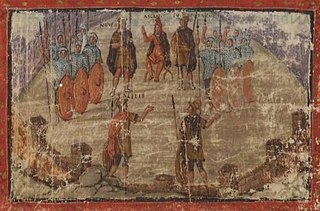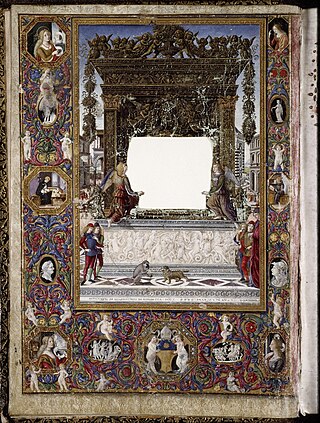
Piero della Francesca was an Italian painter of the Early Renaissance. To contemporaries he was also known as a mathematician and geometer. Nowadays Piero della Francesca is chiefly appreciated for his art. His painting is characterized by its serene humanism, its use of geometric forms and perspective. His most famous work is the cycle of frescoes The History of the True Cross in the church of San Francesco in the Tuscan town of Arezzo.

The Vatican Apostolic Library, more commonly known as the Vatican Library or informally as the Vat, is the library of the Holy See, located in Vatican City, and is the city-state's national library. It was formally established in 1475, although it is much older—it is one of the oldest libraries in the world and contains one of the most significant collections of historical texts. It has 75,000 codices from throughout history, as well as 1.1 million printed books, which include some 8,500 incunabula.

The Pazzi conspiracy was a failed plot by members of the Pazzi family and others to displace the Medici family as rulers of Renaissance Florence.

Federico da Montefeltro, also known as Federico III da Montefeltro KG, was one of the most successful mercenary captains (condottieri) of the Italian Renaissance, and lord of Urbino from 1444 until his death. A renowned intellectual humanist and civil leader in Urbino on top of his impeccable reputation for martial skill and honour, he commissioned the construction of a great library, perhaps the largest of Italy after the Vatican, with his own team of scribes in his scriptorium, and assembled around him a large humanistic court in the Ducal Palace, Urbino, designed by Luciano Laurana and Francesco di Giorgio Martini.

The Vergilius Vaticanus, also known as Vatican Virgil, is a Late Antique illuminated manuscript containing fragments of Virgil's Aeneid and Georgics. It was made in Rome in around 400 CE, and is one of the oldest surviving sources for the text of the Aeneid. It is the oldest and one of only three ancient illustrated manuscripts of classical literature.

The Vergilius Romanus, also known as the Roman Vergil, is a 5th-century illustrated manuscript of the works of Virgil. It contains the Aeneid, the Georgics, and some of the Eclogues. It is one of the oldest and most important Vergilian manuscripts. It is 332 by 323 mm with 309 vellum folios. It was written in rustic capitals with 18 lines per page.

Fossombrone is a town and comune in the province of Pesaro and Urbino, in the Marche region of central Italy.

Francesco Berlinghieri (1440–1501) was an Italian scholar and humanist who lived during the fifteenth century. He promoted the value of classical Greek learning and was one of the first to print a text based on Ptolemy's Geographica. Berlinghieri studied poetry under the tutelage of Cristoforo Landino.

Giovanni Santi was an Italian painter and decorator, father of Raphael. He was born in 1435 at Colbordolo in the Duchy of Urbino. He studied under Piero della Francesca and was influenced by Fiorenzo di Lorenzo. He was court painter to the Duke of Urbino and painted several altarpieces. He died in Urbino.

Federico I Gonzaga was marquis of Mantua from 1478 to 1484, as well as a condottiero.

Francesco Rosselli was an Italian miniature painter, and engraver of maps and old master prints. He was described as a cartographer, although his contribution did not include any primary research and was probably limited to engraving, decorating and selling manuscript maps created by others. He created many maps, including one of the first printed maps of the world to incorporate the discoveries of Christopher Columbus in the Americas. The attribution of prints to him is the subject of debate, as different engraving styles are used. This may be the result of different artists in his workshop, or of his and his shop's ability to use different styles.

Alessandro Sforza was an Italian condottiero and lord of Pesaro, the first of the Pesaro line of the Sforza family.
The decade of the 1470s in art involved some significant events.

The Bible of San Paolo fuori le Mura is a 9th-century illuminated Bible. Of all surviving Carolingian Bibles, it is the most thoroughly illuminated.

The Menologion, Menologium, or Menology of Basil II is an illuminated manuscript designed as a church calendar or Eastern Orthodox Church service book (menologion) that was compiled c. 1000 AD for the Byzantine Emperor Basil II. It contains a synaxarion, a short collection of saints' lives, compiled at Constantinople for liturgical use and around 430 miniature paintings by eight different artists. It was unusual for a menologion from that era to be so richly painted. It currently resides in the Vatican Library . A full facsimile was produced in 1907.

Francesco di Antonio del Chierico (1433–1484) was a manuscript illuminator of the early Renaissance period in Florence. Francesco began as a goldsmith before changing occupations to become a successful illustrator. He was one of the pupils of Fra Angelico and became famous for being Lorenzo de' Medici's favorite illuminator. He worked under some of the most prestigious patrons of the time, including Lorenzo de' Medici, Piero de’ Cosimo de' Medici, Cosimo il Vecchio, and Vespasiano da Bisticci. He gained a reputation for his well executed illustrations in varying types of books ranging in size from small books of hours to large choir books. His illustrations often included intricate floral arrangements, putti, and candelabras. He decorated both the borders of manuscripts and full pages.

The Bible of Borso d'Este is a two-volume manuscript. The illuminated miniatures, work of Taddeo Crivelli and others, were executed between 1455 and 1461. The work is held in the Biblioteca Estense di Modena.

Gianfrancesco Enzola was an Italian medallist, known as il Parmense.

The Metropolitan Museum of Art has on display a complete studio from the Palazzo ducale di Gubbio. Consisting of period woodwork from late 15th century Italy, the studio was commissioned for Federico da Montefeltro.

The Missal of Thomas James is an illuminated manuscript produced around 1483 for Thomas James, Bishop of Dol in Brittany. It represents the text of a missal for use in Rome and was commissioned by the Breton prelate, who was close to Pope Sixtus IV and Italian humanist circles while living in the papal city. The work was produced by the Italian painter Attavante degli Attavanti and the people of his studio in Florence. It contains two full-page miniatures, two-thirds-page miniatures, 165 historiated initials, and numerous margins decorated with medallions depicting saints or scenes from the life of Christ. These decorations are representative of Florentine Renaissance art, inspired by ancient objects and Flemish art. It served as a model for other manuscripts by the same painter, including The Missal of Matthias Corvin. The manuscript remained in Dol-de-Bretagne until the 19th century when it was sold and acquired by an archbishop of Lyon. It is currently kept in the Bibliothèque Municipale de Lyon under the reference Ms.5123. However, it has been partially mutilated: the frontispiece has been cut out and five sheets have been removed. One of them, depicting the Crucifixion, is kept in the Museum of Modern Art André Malraux in Le Havre.




















